| TEXTILES FROM THE SILK ROAD IN THE METROPOLITAN MUSEUM OF ART | |
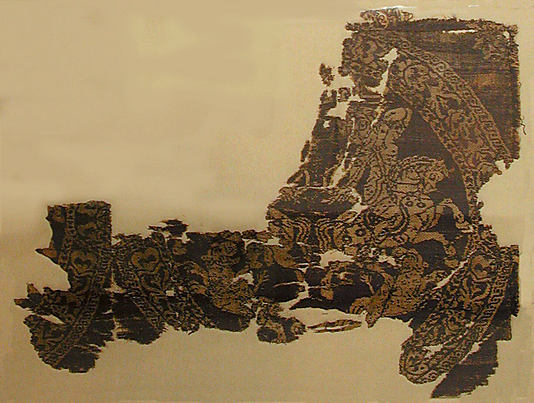 | Fragment - Object Name:
- Fragment
- Date:
- 8th century
- Geography:
- Egypt or Syria
- Medium:
- Silk; samite
- Dimensions:
- Textile: H. 8 1/4 in. (21 cm) W. 11 in. (28 cm) Mount: H. 12 in. (30.5 cm) W. 14 3/4 in. (37.5 cm) D. 1 1/4 in. (3.2 cm)
- Classification:
- Textiles-Woven
- Credit Line:
- Gift of Mrs. Hayford Peirce, 1987
- Accession Number:
- 1987.440.1
- Provenance
[ Giorgio Sangiorgi, Rome, by 1906–34; sold to Peirce]; Mrs. Hayford Peirce, San Diego, CA (1934–87)
|
| | |
 | Fragment - Object Name:
- Fragment
- Date:
- 5th–6th century
- Geography:
- Iran
- Medium:
- Silk
- Dimensions:
- 8.5 in. high 8.00 in. wide (21.6 cm high 20.3 cm wide)
- Classification:
- Textiles-Woven
- Credit Line:
- Rogers Fund, 1907
- Accession Number:
- 07.243.2
This artwork is not on display |
 | Textile Fragment with Hunting Scene - Object Name:
- Fragment
- Date:
- 8th century
- Geography:
- Egypt or Syria
- Medium:
- Silk; samite
- Dimensions:
- Textile: H. 9 1/2 in. (24.1 cm) W. 6 3/4 in. (17.1 cm) Mount: H. 13 3/4 in. (34.9 cm) W. 10 1/4 in. (26 cm)
- Classification:
- Textiles-Woven
- Credit Line:
- Rogers Fund, 1951
- Accession Number:
- 51.57
- Signatures, Inscriptions, and Markings
Inscription: Above the heads of the figures is an inscription in kufic (bismallah).
|
| | |
| | |
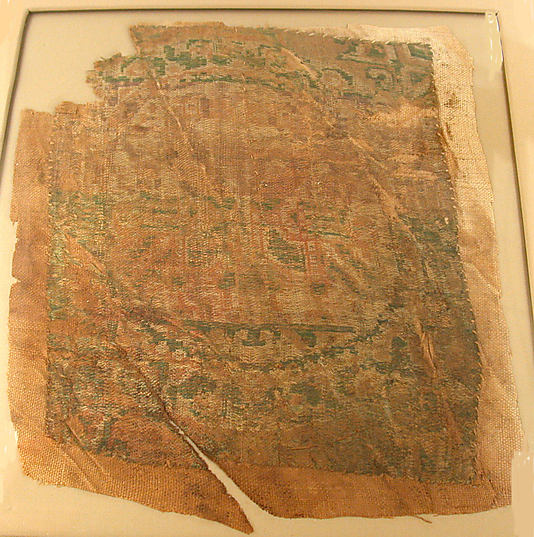 | Textile fragment with ducks in roundel - Period:
- early Islamic
- Date:
- ca. 8th–9th century A.D.
- Geography:
- Central Asia or Caucasus region
- Culture:
- Islamic
- Medium:
- Silk
- Dimensions:
- H. 6.3 in. (17.1 cm); W. 8 in. (20.3 cm)
- Classification:
- Textiles-Woven
- Credit Line:
- Gift of Nanette B. Kelekian, in memory of Charles Dikran and Beatrice Kelekian, 1999
- Accession Number:
- 1999.325.230
|
| | |
| | |
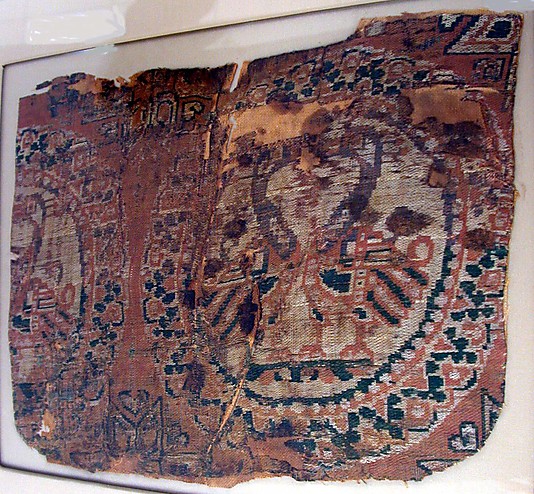 | Textile fragment with ducks in roundels - Period:
- early Islamic
- Date:
- ca. 8th–9th century A.D.
- Geography:
- Central Asia or Caucasus region
- Culture:
- Islamic
- Medium:
- Silk
- Dimensions:
- H. 8 in. (20.3 cm); W. 10 1/2 in. (26.7 cm)
- Classification:
- Textiles-Woven
- Credit Line:
- Gift of Nanette B. Kelekian, in memory of Charles Dikran and Beatrice Kelekian, 1999
- Accession Number:
- 1999.325.229
|
| | |
| | |
 | Fragment - Object Name:
- Fragment
- Date:
- 8th–9th century
- Geography:
- Egypt or Syria
- Medium:
- Silk; samite
- Dimensions:
- Textile: H. 6 1/8 in. (15.5 cm) W.7 5/16 in. (18.5 cm) Mount: H. 9 7/8 in. (25.1 cm) W. 10 3/4 in. (27.3 cm) D. 1 1/4 in. (3.2 cm)
- Classification:
- Textiles-Woven
- Credit Line:
- Rogers Fund, 1917
- Accession Number:
- 17.22.1
- Provenance
[ Dikran G. Kelekian, New York, until 1917; sold to MMA]
|
| | |
| | |
 | |
| | |
| | |
 | |
| | |
| | |
 | Medallion from a Tunic - Object Name:
- Medallion
- Date:
- 6th–7th century
- Geography:
- Syria
- Medium:
- Silk; samite (weft-faced compound twill)
- Dimensions:
- Textile: H. 8 3/4 in. (22.2 cm) W. 7 7/8 in. (20 cm) Mount: H. 12 3/4 in. (32.4 cm) W. 11 1/2 in. (29.2 cm) D. 1 1/4 in. (3.2 cm)
- Classification:
- Textiles-Woven
- Credit Line:
- Rogers Fund, 1927
- Accession Number:
- 27.58.1
This artwork is currently on display in Gallery 451 Provenance [ Adolph Loewi, Venice, until 1927; sold to MMA] |
| | |
| | |
|
|
| | |
| | |
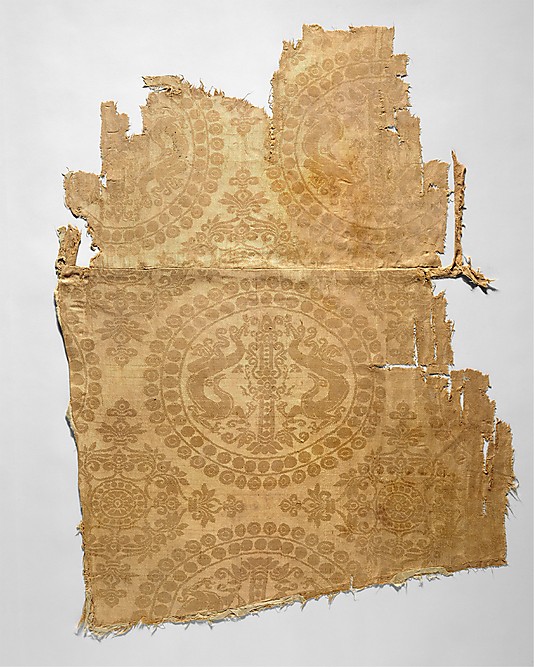 | Textile with Pearl Roundels with Dragons - Date:
- late 8th–9th century
- Culture:
- China or Central Asia
- Medium:
- Silk
- Dimensions:
- Max height (warp): 18 1/8in. (46cm) Max width (weft): 24 7/16in. (62.1cm)
- Classification:
- Textiles-Woven
- Credit Line:
- Purchase, Barbara and William Karatz Gift, 1998
- Accession Number:
- 1998.147
|
| | |
| | |
 | Textile with Floral Medallion - Period:
- Tang dynasty (618–907)
- Date:
- late 8th–early 9th century
- Culture:
- China
- Medium:
- Woven silk: weft-faced compound twill
- Dimensions:
- Overall: 24 x 28 in. (61 x 71.1 cm) Mount (with plexi cover): 28 3/4 x 32 1/2 in. (73 x 82.6 cm)
- Classification:
- Textiles-Woven
- Credit Line:
- Purchase, Joseph Pulitzer Bequest, 1996
- Accession Number:
- 1996.103.1
- Description
An arrangement of floral medallions interspersed with quatrefoil motifs was one of the dominant textile patterns of the High Tang period (roughly the first half of the eighth century). A textile with a similar large floral medallion has been preserved as part of the Shôsô-in collection from the mid-eighth-century imperial repository in Nara, Japan. However, an aspect of this work's weave structure-namely, that it is bound in weft-faced twill on both the face and the reverse-is more commonly seen in textiles of the tenth century and later.
|
| | |
| | |
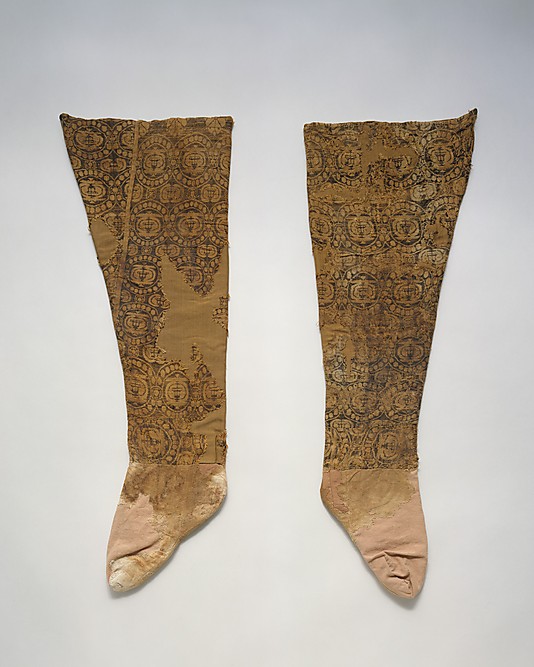 | Leggings - Date:
- ca. 8th century A.D.
- Geography:
- Caucasus region
- Medium:
- Silk, linen
- Dimensions:
- 31.5 in. (80.01 cm)
- Classification:
- Textiles-Costumes
- Credit Line:
- Harris Brisbane Dick Fund, 1996
- Accession Number:
- 1996.78.2a, b
This artwork is currently on display in Gallery 405 Provenance 1994, sold at the Stuttgarter Kunst-Auktionshaus Dr. Fritz Nagel, Stuttgart, May 7, 1994, no. 18; acquired by the Museum in 1996, purchased from Rossi & Rossi Ltd., London |
| | |
| | |
 | Caftan - Date:
- ca. 8th century A.D.
- Geography:
- Caucasus region
- Medium:
- Silk, linen, fur
- Dimensions:
- L. 56 in. (142. 2 cm)
- Classification:
- Textiles-Costumes
- Credit Line:
- Harris Brisbane Dick Fund, 1996
- Accession Number:
- 1996.78.1
This artwork is currently on display in Gallery 405 The original linen coat (caftan), preserved in part from the neck to the bottom of the hem, is made of finely woven linen. A decorative strip of large-patterned silk is sewn along the exterior and interior edges of the caftan. A minute fragment of lambskin preserved as the caftan's interior attests to its fur lining. The woven patterns on the silk borders of the caftan include motifs such as the rosettes and stylized animal patterns enclosed within beaded roundels, which were widespread in Iranian and Central Asian textiles of the sixth to ninth century. The colors used in the textile include a now-faded dark blue, yellow, red, and white on a dark brown ground. The decorated silk fabrics are a compound twill weave (samite in modern classification) and the body of the garment is plain-weave linen. Two slits running up the back of the caftan make it particularly suitable as a riding costume. |
 | Textile fragment - Period:
- Sasanian
- Date:
- ca. 6th–7th century A.D.
- Geography:
- Iran
- Culture:
- Sasanian
- Medium:
- Silk, samit
- Dimensions:
- 1 x 2 in. (2.5 x 5.1 cm)
- Classification:
- Textiles-Woven
- Credit Line:
- Gift of Ronald Antonioli and Guitty Azarpay, 2000
- Accession Number:
- 2000.624.4
|
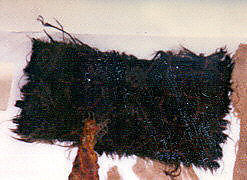 | Textile fragment - Period:
- Sasanian
- Date:
- ca. 6th–7th century A.D.
- Geography:
- Iran
- Culture:
- Sasanian
- Medium:
- Silk, samit
- Dimensions:
- 2.75 x 4.75 in. (7 x 12.1 cm)
- Classification:
- Textiles-Woven
- Credit Line:
- Gift of Ronald Antonioli and Guitty Azarpay, 2000
- Accession Number:
- 2000.624.3
|
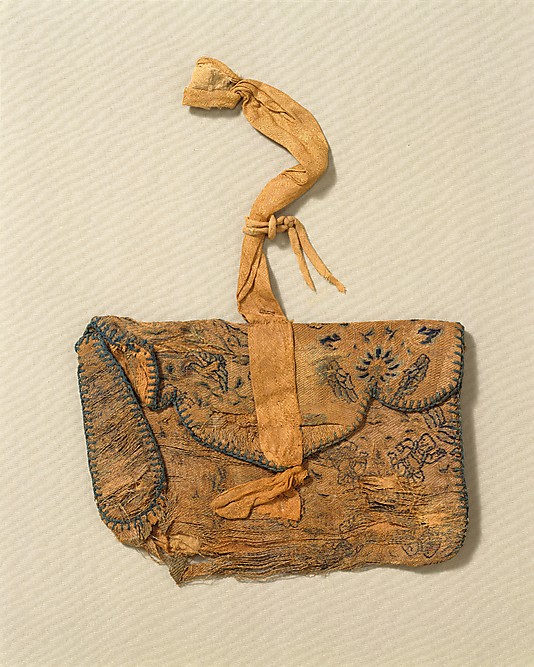 | Purse - Period:
- Tang dynasty (618–907)
- Date:
- 8th–9th century
- Culture:
- China
- Medium:
- Silk
- Dimensions:
- 5 5/8 x 5 3/8 x 1 in. (14.3 x 13.7 x 2.5 cm)
- Classification:
- Textiles-Woven
- Credit Line:
- Purchase, Eileen W. Bamberger Bequest, in memory of her husband, Max Bamberger, 1996
- Accession Number:
- 1996.39
|
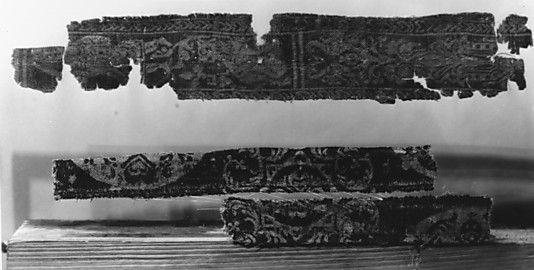 | Fragment - Object Name:
- Fragment
- Date:
- 6th–7th century
- Geography:
- probably Syria
- Medium:
- Silk; samite (?)
- Dimensions:
- 30 in. high 4.00 in. high (76.2 cm high cm high)
- Classification:
- Textiles-Woven
- Credit Line:
- Gift of George F. Baker, 1890
- Accession Number:
- 90.5.17
|
| | |
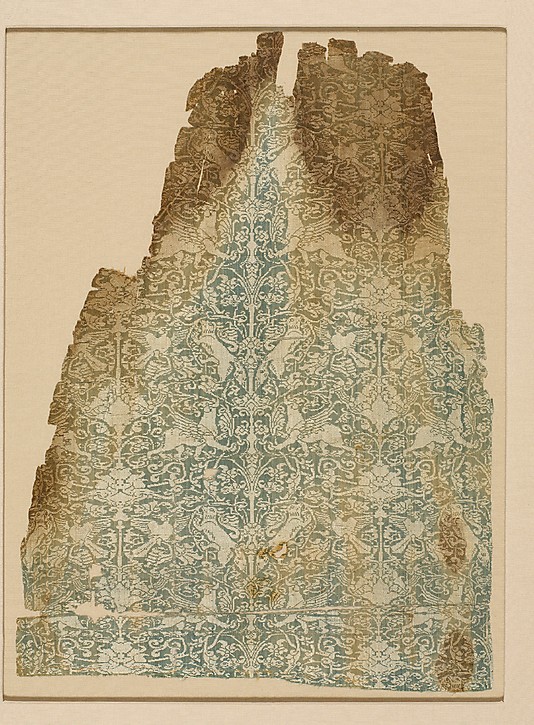 | |
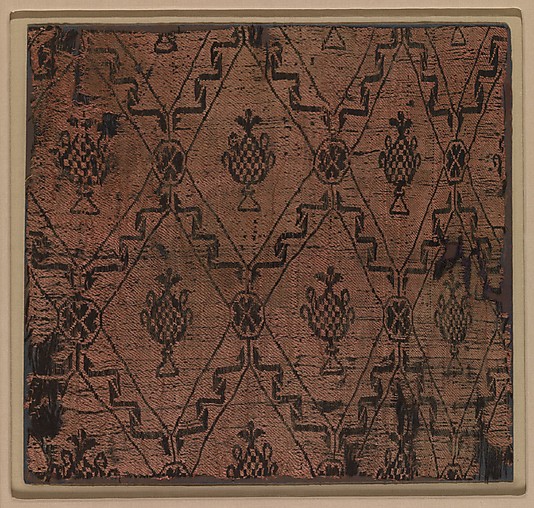 | Fragment - Object Name:
- Fragment
- Date:
- 7th–8th century
- Geography:
- probably Iran
- Medium:
- Silk
- Classification:
- Textiles-Woven
- Credit Line:
- Fletcher Fund, 1946
- Accession Number:
- 46.156.13
This artwork is currently on display in Gallery 999 |
 | Fragment - Object Name:
- Fragment
- Date:
- 5th–6th century
- Geography:
- Iran
- Medium:
- Silk
- Dimensions:
- 8 in. high 6.00 in. wide (20.3 cm high 15.2 cm wide)
- Classification:
- Textiles-Woven
- Credit Line:
- Rogers Fund, 1907
- Accession Number:
- 07.243.1
This artwork is not on display |
 | Textile with Processions of Rams - Date:
- 7th–8th century
- Culture:
- Central Asia or Eastern Iran
- Medium:
- Silk samite (weft-faced compound twill)
- Dimensions:
- Before Conservation: Warp 19 7/8 in. (50.5 cm); Weft 15 9/16 in. (39.5 cm)
- Classification:
- Textiles-Woven
- Credit Line:
- Purchase, Friends of Asian Art Gifts, 2005
- Accession Number:
- 2005.134
|
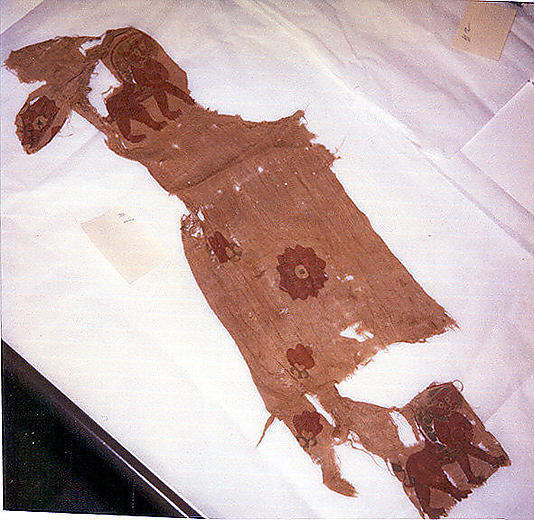 | Textile fragment - Period:
- Sasanian
- Date:
- ca. 6th–7th century A.D.
- Geography:
- Iran
- Culture:
- Sasanian
- Medium:
- Silk, tapestry weave
- Dimensions:
- 21 x 6 in. (53.3 x 15.2 cm)
- Classification:
- Textiles-Woven
- Credit Line:
- Gift of Ronald Antonioli and Guitty Azarpay, 2000
- Accession Number:
- 2000.624.1
|
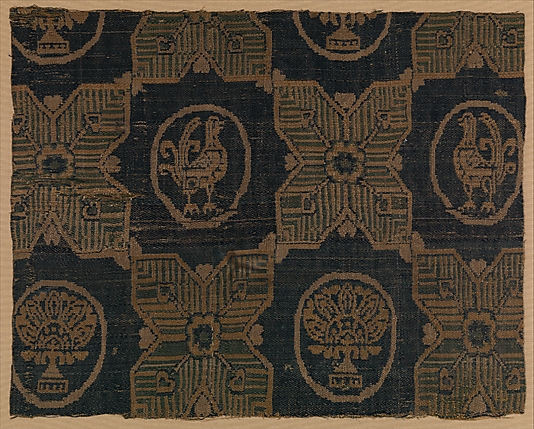 | Fragment - Date:
- 8th–9th century
- Geography:
- probably Iran
- Medium:
- Silk; samite
- Dimensions:
- Textile: H. 8 1/4 in. (21 cm) W. 10 1/4 in. (26 cm) Mount: H. 11 7/8 (30.2 cm) W. 13 7/8 in. (35.2 cm) D. 1 1/4 in. (3.2 cm)
- Classification:
- Textiles
- Credit Line:
- Fletcher Fund, 1946
- Accession Number:
- 46.156.6
This silk textile fragment displays a repeating design executed in green, yellow, and tan against a dark blue ground. The design consists of joined rows of four-pointed stars, in between which are roundels bearing stylized floral and bird forms in alternating rows. |
 | Roundel - Object Name:
- Roundel
- Date:
- 6th–7th century
- Geography:
- Iraq or Syria
- Medium:
- Silk
- Dimensions:
- H: 5 1/4 in. (13.3 cm) W: 5 in. (12.7 cm)
- Classification:
- Textiles-Woven
- Credit Line:
- Gift of George D. Pratt, 1929
- Accession Number:
- 29.144.2
|
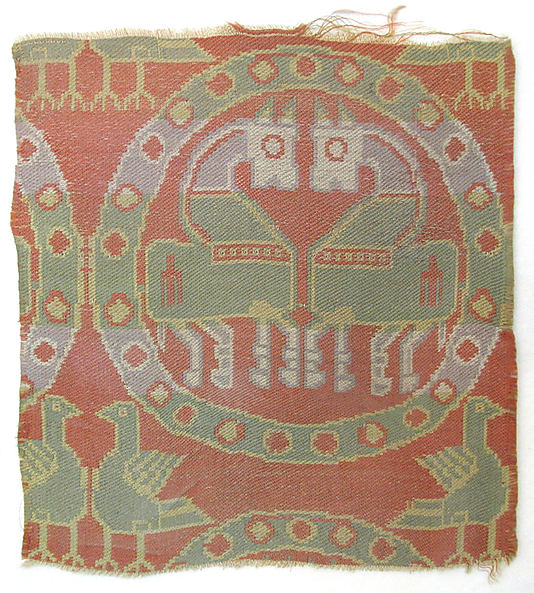 | Fragment - Object Name:
- Fragment
- Date:
- 8th–9th century
- Geography:
- Iran
- Medium:
- Silk; woven
- Dimensions:
- H: 6 in. (15.2 cm) W: 5 1/2 in. (14 cm)
- Classification:
- Textiles-Woven
- Credit Line:
- Rogers Fund, 1938
- Accession Number:
- 38.147
|
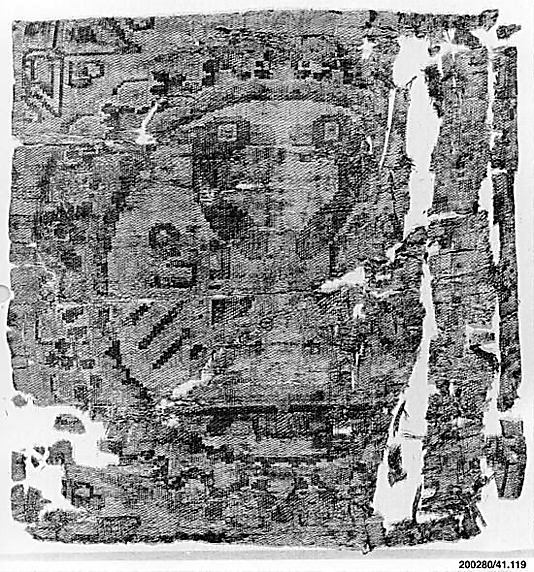 | Fragment - Object Name:
- Fragment
- Date:
- 8th–9th century
- Geography:
- Iran
- Medium:
- Silk; tapestry-woven
- Dimensions:
- H: 7 3/4 in. (19.7 cm) W: 8 in. (20.3 cm)
- Classification:
- Textiles-Woven
- Credit Line:
- Rogers Fund, 1941
- Accession Number:
- 41.119
This artwork is not on display |
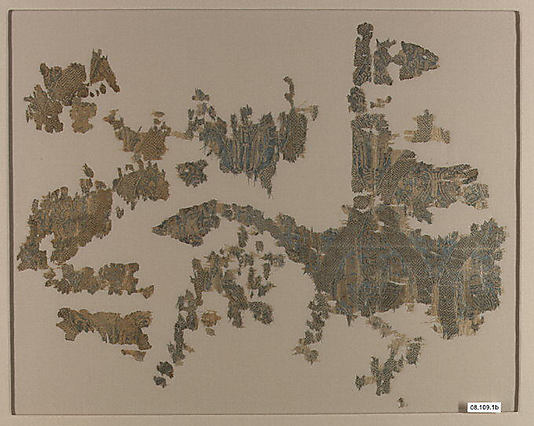 | |
| | |
| | |
 | Textile with Confronted Horned Animals in a Pearl Roundel - Date:
- 7th–9th century
- Culture:
- Sogdian (Central Asia)
- Medium:
- Woven silk: weft-faced compound twill (samite)
- Dimensions:
- Overall: 10 x 15 1/2 in. (25.4 x 39.4 cm) b.: 9 3/4 x 15 in. (24.8 x 38.1 cm) Mount (with plexi cover): 24 1/4 x 19 3/4 in. (61.6 x 50.2 cm)
- Classification:
- Textiles-Woven
- Credit Line:
- Rogers Fund, 1996
- Accession Number:
- 1996.1a, b
- Description
This piece is a composite of two halves of a roundel from different parts of the same length of cloth. Together, they form slightly more than one pearl roundel containing confronted horned animals, probably bulls. The textile represents a type that was known to early Arab historians and geographers as Zandaniji. A complete loom piece of the type in Huy, Belgium, bears an inscription with the word Zandaniji written in the language of Sogdian merchants, who were the most important intermediaries in the silk trade during the Tang dynasty (618–907). The patterns of these silks derive from the arts of the late Sasanian period (224–637), but technical aspects set them apart from other textiles with similar patterns.
|
| | |
| | |
 | Textile, fragments - Object Name:
- Textile, fragments
- Date:
- 6th–7th century
- Geography:
- probably Egypt or Syria
- Medium:
- Silk
- Classification:
- Textiles-Woven
- Credit Line:
- Fletcher Fund, 1946
- Accession Number:
- 46.156.18b, c
|
| | |
| | |
 | Shosoin fragment - Period:
- Tang dynasty (618–907)
- Culture:
- China
- Medium:
- Silk compound twill
- Classification:
- Textiles-Woven
- Credit Line:
- Seymour Fund, 1965
- Accession Number:
- 65.213.2
|
| | |
| | |
 | Twill damask with paired birds and floral pattern - Date:
- late 8th–9th century
- Culture:
- China
- Medium:
- Silk
- Dimensions:
- Overall (warp) 27-9/16 x overall weft: 21-5/8 in. (70.0 x 54.9 cm)
- Classification:
- Textiles-Woven
- Credit Line:
- Purchase, Joseph Hotung, Brooke Astor, and Barbara and William Karatz Gifts, 1998
- Accession Number:
- 1998.274
|
| | |
| | |
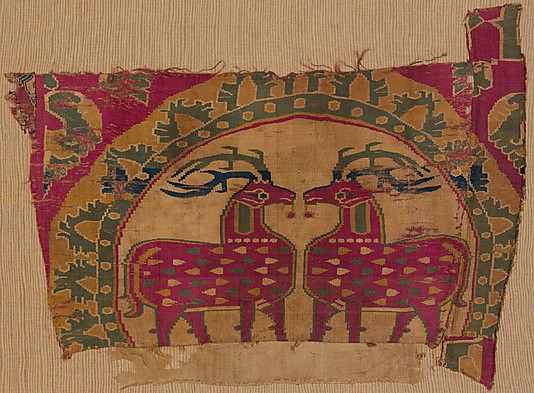 | Textile Fragment with Confronted Deer in Partial Pearl Roundel with Serrated Outer Border - Date:
- 8th–9th century
- Culture:
- Eastern Iran or Sogdiana
- Medium:
- Silk
- Dimensions:
- 13 3/8 x 17 5/16 in. (34 x 44 cm)
- Classification:
- Textiles-Woven
- Credit Line:
- Purchase, Rogers Fund, by exchange, 2006
- Accession Number:
- 2006.472
|
| | |
| | |
 | Fragment - Period:
- Nara period (710–794), Tempyô (729–749)
- Date:
- 8th century
- Culture:
- Japan
- Medium:
- Silk / Brocaded
- Dimensions:
- 100 x 100 in. (253.98 x 253.97 cm)
- Classification:
- Textiles-Woven
- Credit Line:
- Rogers Fund, 1944
- Accession Number:
- 44.48.11c
|
| | |
| | |
 | Roundel with Amazons and a Cross - Date:
- 7th–9th century (?)
- Geography:
- Made in, Egypt or Syria (?)
- Culture:
- Byzantine
- Medium:
- Weft-faced compound twill (samit) in green, beige, and brownish silk
- Dimensions:
- 8 3/16 x 8 1/4 in. (20.8 x 20.9 cm)
- Classification:
- Textiles-Woven
- Credit Line:
- Gift of Mrs. Hayford Peirce, 1987
- Accession Number:
- 1987.442.5
This artwork is currently on display in Gallery 999 |
| | |
| | |
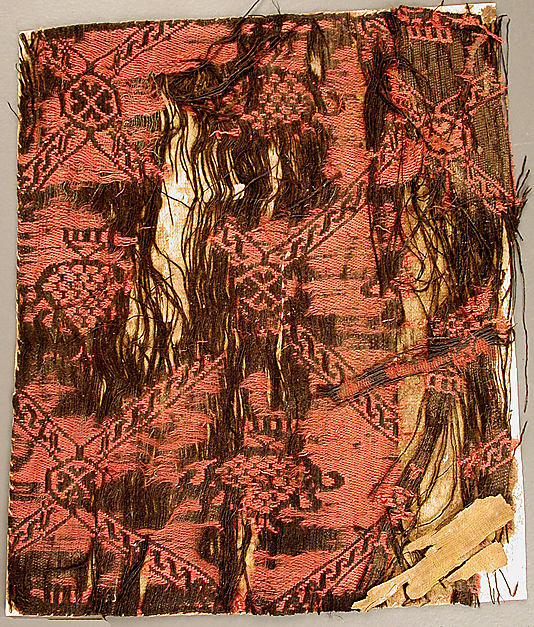 | Guilloche Lattice with Pinecone (?) - Date:
- 7th–9th century
- Geography:
- Made in, Egypt
- Culture:
- Byzantine
- Medium:
- Weft-faced compound twill (samit) in red, black, and blue silk
- Dimensions:
- Overall: 7 7/8 x 6 5/8in. (20 x 16.9cm) Framed: 12 1/4 x 11 x 1 1/2 in. (31.1 x 27.9 x 3.8 cm)
- Classification:
- Textiles-Woven
- Credit Line:
- Gift of Nanette B. Kelekian, in honor of Nobuko Kajitani, 2002
- Accession Number:
- 2002.239.27
This artwork is currently on display in Gallery 999 |
 | Woven Tapestry Fragment - Object Name:
- Fragment
- Date:
- mid-8th century
- Geography:
- Iran, Iraq, or Egypt
- Medium:
- Wool; tapestry weave
- Dimensions:
- Textile: L. 12 in. (30.5 cm) W. 18 3/4 in. (47.6 cm) Mount: L. 23 13/16 in. (60.5 cm) W. 17 13/16 in. (45.2 cm) D. 7/8 in. (2.2 cm)
- Classification:
- Textiles
- Credit Line:
- Rogers Fund, 1950
- Accession Number:
- 50.83
- The overall pattern on this tapestry-woven cloth, possibly a floor covering, with staggered rows of rosettes, resembles textiles depicted on the rock reliefs of the late sixth- to early seventh-century Sasanian monument at Taq-i Bustan. On the basis of inscriptions on two closely related textiles, this fragment has been dated to the reign of the Umayyad caliph Marwan II (r. 744–49).
|
| | |
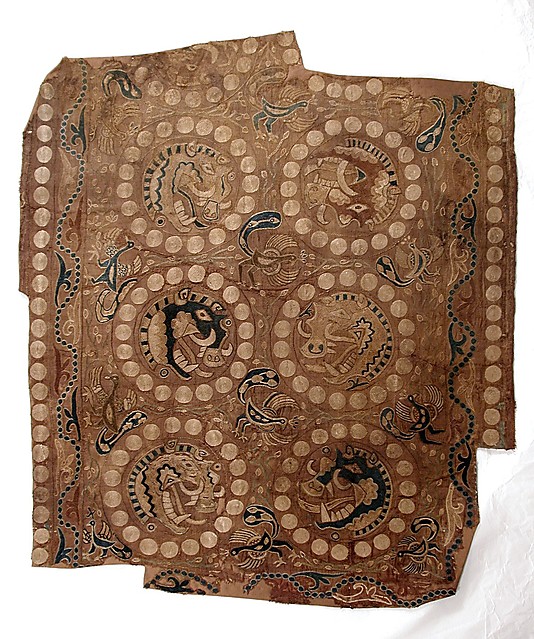 | Boar's Head Roundels - Date:
- 7th century
- Culture:
- Central Asia
- Medium:
- Silk split-stitch embroidery on plain-weave silk
- Dimensions:
- Warp 22 1/16 in. (56 cm); weft (selvedge to selvedge) 18 7/8 in. (48 cm)
- Classification:
- Textiles-Embroidered
- Credit Line:
- Purchase, Sir Joseph Hotung Gift, 2004
- Accession Number:
- 2004.260
|
| | |
| | |
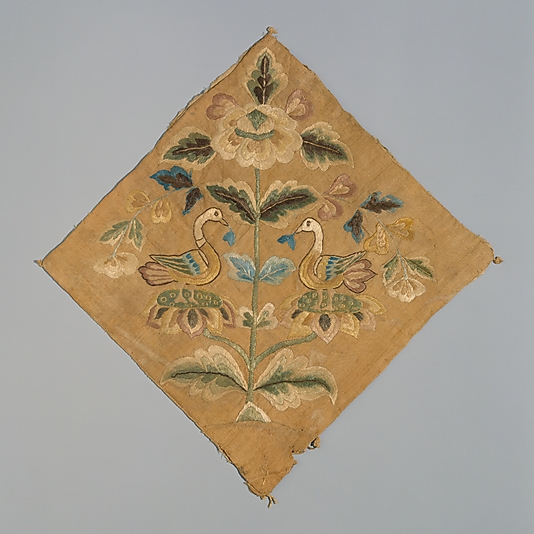 | Textile with Confronted Birds - Period:
- Tang dynasty (618–907)
- Date:
- early 8th century
- Culture:
- China
- Medium:
- Silk embroidery on plain-weave silk
- Dimensions:
- Overall: 12 1/4 x 12 1/8 in. (31.1 x 30.8 cm) Mount (with plexi cover): 15 x 14 1/2 in. (38.1 x 36.8 cm)
- Classification:
- Textiles-Embroidered
- Credit Line:
- Purchase, Joseph Pulitzer Bequest, 1996
- Accession Number:
- 1996.103.2
This artwork is not on display |
| | |
| | |
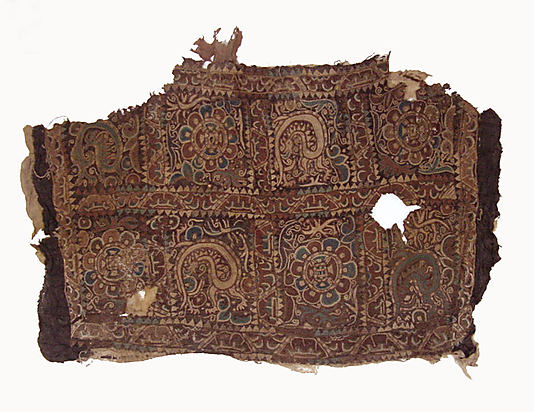 | Embroidered Textile with Dragons and Lotuses - Period:
- Tang dynasty (618–907)
- Date:
- 7th–8th century
- Culture:
- China
- Medium:
- Silk
- Dimensions:
- 8 11/16 x 13 3/8 in. (22 x 34 cm)
- Classification:
- Textiles-Embroidered
- Credit Line:
- Purchase, The B. D. G. Leviton Foundation Gift, 2007
- Accession Number:
- 2007.296a, b
|
| | |
| | |
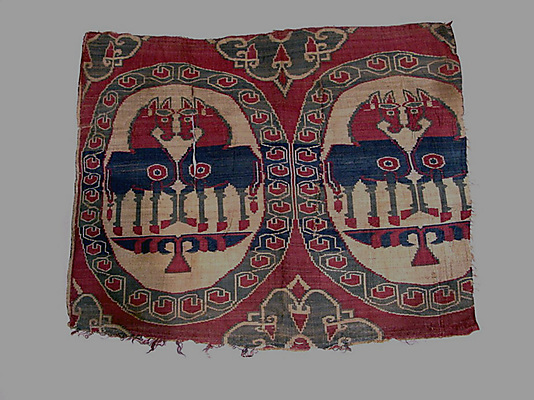 | Textile with Confronted Horses in Roundels - Date:
- 8th–9th century
- Culture:
- Central Asia
- Medium:
- Woven silk
- Dimensions:
- Before conservation: greatest height 15 15/16 in. (40.5 cm) x greatest width 19 1/8 in. (48.6 cm)
- Classification:
- Textiles-Woven
- Credit Line:
- Purchase, The Vincent Astor Foundation Gift, 2006
- Accession Number:
- 2006.173
|
| | |
| | |
 | Woven Textile with Male Bust in Pearl Roundel - Date:
- 7th–8th century
- Culture:
- Central Asia
- Medium:
- Silk
- Dimensions:
- Overall: H. 7 in. (17.8 cm); Warp 26 3/8 in. (67 cm); Weft 6 3/4 in. (17.2 cm)
- Classification:
- Textiles-Woven
- Credit Line:
- Purchase, The Vincent Astor Foundation Gift, 2008
- Accession Number:
- 2008.79
|
| | |
 | Fragment - Object Name:
- Fragment
- Date:
- 5th century
- Geography:
- Iran
- Medium:
- Silk, linen (?); samite (?)
- Dimensions:
- 1 in. high 6.00 in. wide (2.5 cm high 15.2 cm wide)
- Classification:
- Textiles-Woven
- Credit Line:
- Gift of George F. Baker, 1890
- Accession Number:
- 90.5.7a
This artwork is not on display |
 | Fragment - Object Name:
- Fragment
- Date:
- 5th century
- Geography:
- Iran
- Medium:
- Silk; samite (?)
- Classification:
- Textiles-Woven
- Credit Line:
- Gift of George F. Baker, 1890
- Accession Number:
- 90.5.19b
This artwork is not on display |
| | |
| | |
| | |
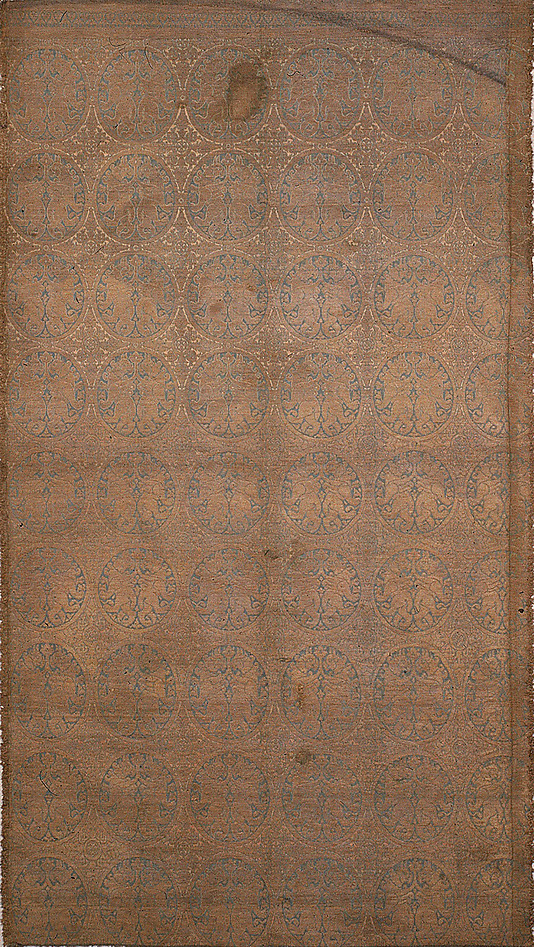 | Woven Silk, with Addorsed Griffins in Roundels and Pseudo-Kufic Inscription - Date:
- late 13th–early 14th century
- Culture:
- Central Asian, Sicilian, or North African
- Medium:
- Silk, silver-gilt metal on parchment over cotton
- Dimensions:
- 69 1/4 x 38 1/4 in. (175.9 x 97.2 cm)
- Classification:
- Textiles-Woven
- Credit Line:
- The Cloisters Collection, 1984
- Accession Number:
- 1984.344
|
| | |



















































